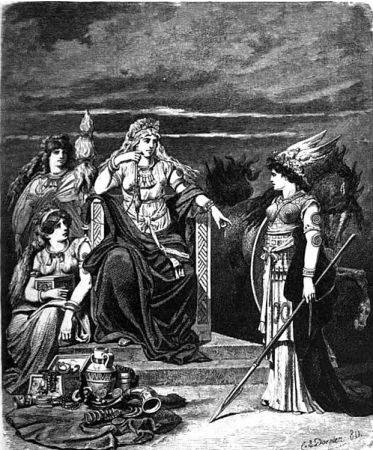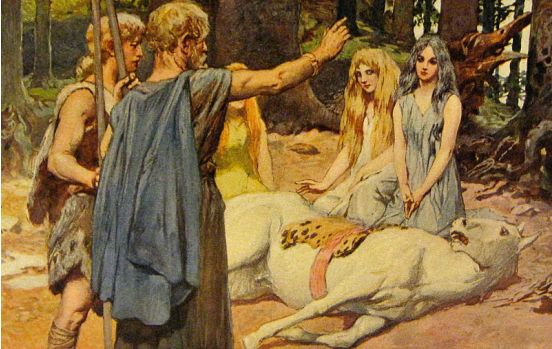Fulla is the goddess of abundance and service, a loyal handmaiden to Frigga, the queen of the Aesir. Not as well known as some other gods and goddesses, Fulla still holds a special place in Norse mythology due to her unwavering support and care for Frigg.
Short Facts
Tribe: Aesir
Goddess of: abundance and service
Handmaiden of: Frigg
Family: Possibly sister of Frigg
Meaning of name: Fulla means “full” or “bountiful” in Old Norse
Other names: Volla, Volla the Wise, Fulla the Bountiful
Origins, Name and Family

The Old Norse name Fulla translates to ‘bountiful’. It originates from Proto-Germanic *fullōn, meaning ‘fullness’ or ‘plenitude’, which is a derivative of the adjective *fullaz, meaning ‘full’. This term comes from Proto-Indo-European *plh₁-nó-, a past participle of the verbal root *pelh₁-, which means ‘to fill’.
Though Fulla’s parentage is not well documented, she is a prominent figure within the Aesir tribe. As Frigg’s handmaiden and confidante, she is closely associated with the queen of the gods, and thus has a significant role in the pantheon.
She is a maiden (virgin) and has no affairs or children that we know of today.
According to the second Merseburg Charm, an ancient German text, Fulla is said to be Frigg’s sister. While this is not mentioned in any of the Icelandic texts, it would explain the close relationship between the goddesses.
Responsibilities and Attributes
Fulla is primarily known as Frigg’s confidante and trusted servant. She assists Frigg in her duties, looking after her personal belongings and ensuring her welfare. As a goddess of abundance, Fulla may also have been called upon to bless fields and bring forth bountiful harvests.
Fulla’s attributes
Fulla is often described as wearing a golden headband, a symbol of her divine status. She is also depicted as a beautiful and wise woman, attributes that have earned her the title “Fulla the Wise” or “Fulla the Bountiful.”
A Maiden of Frigg and the Goddess of Abundance
Fulla’s primary role is as a devoted servant to Frigg, the queen of the Aesir. She is responsible for tending to Frigg’s needs, as well as guarding her personal belongings, including her ashen box, which contains her most precious treasures.

As a goddess of abundance, Fulla is also believed to have had a role in ensuring bountiful harvests, and may have been invoked by the people during times of need for food and sustenance.
This connection with bountiful harvest put Fulla in great company. Both Freyja, who is associated with both agriculture and fertility and Gerdr who is associated with abundance and fertility can be seen as closely tied to her.
Play Fun Norse Quiz
Is this article making you even more curious about Norse gods and goddesses? You can satisfy your curiosity by playing a fun Norse mythology quiz. This way, you can test your knowledge about Norse gods and goddesses, as well as fill in some gaps. Good luck and have fun playing!
Don’t forget to try our other games as well!
Fulla in the Old Texts and Other Places
Fulla is mentioned in the Poetic Edda poem Grímnimál, where she delivers a message to king Geirröd for Frigga.
In the Prose Edda, Fulla is listed as one of the twelve foremost goddesses of the Aesir in Gylfaginning, as well as being mentioned in Skaldskaparmal as Frigg’s handmaiden.
In an anonymous poem listing all the Asynjur, Fulla is also named among the goddesses:
Now all the Ásynjur shall be named: Frigg and Freyja, Fulla and Snotra, Gerðr and Gefjun, Gná, Lofn, Skaði, Jǫrð and Iðunn, Ilmr, Bil, Njǫrun.
As I mentioned already, she is also mentioned in a part of the 9th century, Second Merseburg Charm:
Phol and Wodan were riding to the woods,
and the foot of Balder’s foal was sprained
So Sinthgunt, Sunna’s sister, conjured it;
and Frija, Volla’s sister, conjured it;
and Wodan conjured it, as well he could:
Like bone-sprain, so blood-sprain,
so joint-sprain:
Bone to bone, blood to blood,
joints to joints, so may they be glued.
As this is from Old Germanic Mythology, I want to add that Wodan is Odin, Phol is Balder, Frija is Frigg and finally Volla is Fulla.

Sinthgunt however is an unknown character, but Sunna is the same as the Old Norse Sól, the personification of the sun.
Numerous mentions in Skáldskaparmál
When doing some research about Fulla I found that she is actually mentioned several times in Snorri’s Skáldskaparmál. The mentions position her as maybe a more central goddess than one might think.
At the very beginning of Skáldskaparmál the narrator sets the stage with the major Aesir gods and goddesses going to a banquet at Aegir’s hall. Coincidentally, they are likewise visiting Aegir’s hall in both the Lokasenna and Hymiskvida.
Anyways, the second paragraph in Skáldskaparmál goes like this:
“Then the Aesir came to their banquet, and in the high-seats they sat down those twelve Aesir who were appointed to be judges. These were their names: Thor, Njördr, Freyr, Týr, Heimdallr, Bragi, Vídarr, Váli, Ullr, Hoenir, Forseti, Loki; and in like manner the Ásynjur: Frigg, Freyja, Gefjun, Idunn, Gerdr, Sigyn, Fulla, Nanna.”
So she is at least among the top eight of the Ásynjur (Aesir goddesses) based on this.
Later, Fulla is used in a periphrase for Frigg, “How should one periphrase Frigg? Call her….., Mistress of Fulla”
Then finally, she is connected with gold, as she was known to be wearing a gold headband or hair-net. This comes up in two places, and they go like this:
“How should gold be paraphrased? Thus: by calling it…., Snood of Fulla.”
Then later,
XXXVI – Gold as Fulla’s Snood
“One may hear how gold is metaphorically called Fulla’s Snood, in this verse which Eyvindr Skald-Despoiler wrought:
Fulla’s shining Fillet,
The forehead’s sun at rising,
Shone on the swelling shield-hill
For skalds all Hakon’s life-days.
To clarify, a “Snood” is an ornamental hairnet or fabric bag worn over the hair at the back of a woman’s head. Likewise, an older meaning of fillet is: “a ribbon worn around the head.” Both of these meanings go back to her golden headband or hairnet.
Fulla in Modern Interpretations and Revivals
In modern times, Fulla has become a subject of interest among scholars, artists, and practitioners of Norse paganism. Her representation as a loyal and wise handmaiden to Frigg, as well as her role as a goddess of abundance, makes her an intriguing figure for those looking to explore lesser-known aspects of Norse mythology.
Various works of art, literature, and even rituals have been inspired by Fulla. Moreover, people continue to find meaning in her story and attributes. Fulla may not be as well-known as some other gods and goddesses. However, her role in Norse mythology continues to hold importance for those who study and appreciate the history of the Norse pantheon.
FAQs about Fulla
Fulla is a goddess of abundance and service in Norse mythology, primarily known for her role as a loyal handmaiden and confidante to Frigg, the queen of the Aesir.
Fulla’s name means “full” or “bountiful” in Old Norse, reflecting her role as a goddess of abundance.
Fulla is often depicted as a beautiful and wise woman, wearing a golden headband that signifies her divine status.
Fulla’s primary responsibilities include attending to Frigg’s needs, guarding her personal belongings, and possibly ensuring bountiful harvests as a goddess of abundance.
Fulla is mentioned in both the Poetic and Prose Eddas, with references to her role as Frigg’s handmaiden and her status as one of the twelve foremost goddesses of the Aesir.
In modern interpretations, Fulla is an intriguing figure for scholars, artists, and practitioners of Norse paganism due to her loyalty, wisdom, and role as a goddess of abundance.
Featured Image Credit: Ludwig Pietsch (1824-1911), Public domain, via Wikimedia Commons
